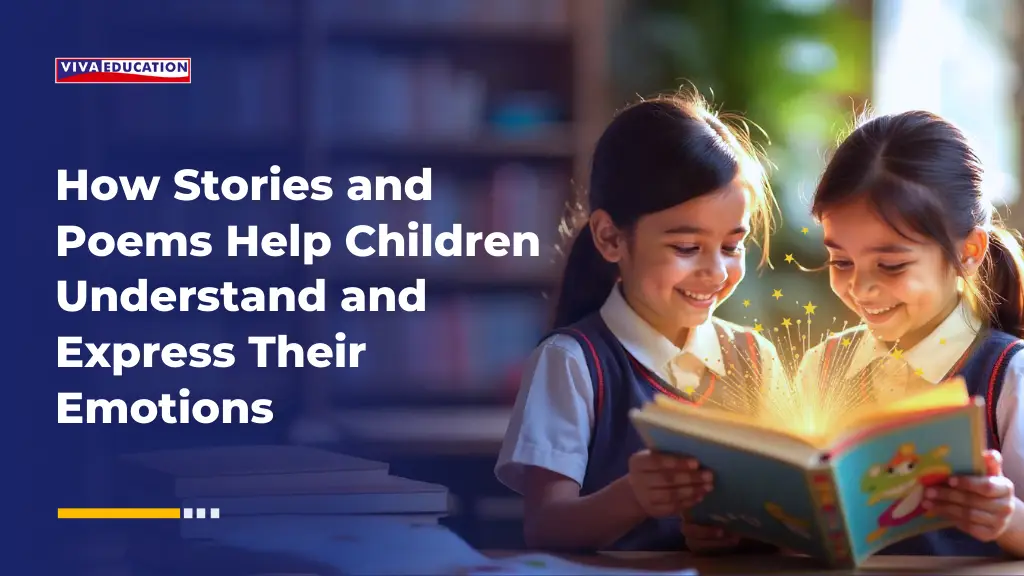How Stories and Poems Help Children Understand and Express Their Emotions
- Teachers
- April 1, 2025
- Viva Education

Consider a student sitting in a classroom, gazing out the window, their thoughts weighed down by anxieties they cannot articulate. Maybe it’s a feeling they don’t fully comprehend, the strain of school, or a friendship gone awry. Research suggests that one in five children nowadays battle with mental health issues, and the percentage is constantly rising.
Now think of this: instead of feeling hopeless, the student opens a book and discovers a poem or a story that reflects their feelings. Their unknown emotion has an identity, and they can recognise it. Stories and poems help children recognise and express emotions, making it easier to understand their feelings.
When children and adults see their emotions mirrored in stories or poems, they feel less alone, learn to process their feelings in a healthy way and develop the confidence to talk about them. This emotional awareness builds resilience, reduces stress, and strengthens well-being.
Why Stories and Poetry Matter for Children’s Well-Being
Poetry and storytelling are scientifically shown to help with emotional processing, stress reduction, and empathy development. They help children understand complex emotions, develop coping skills, and discover joy in self-expression.
Let’s look at how stories and poems can promote wellness, help youngsters understand their emotions, and give them the confidence to navigate the world.
The Power of Stories
When children read a story, their minds are actively processing emotions, imagining scenarios, and making connections between the characters’ experiences and their own feelings.
As they follow the story, their brain releases oxytocin, the hormone responsible for empathy and emotional bonding. This helps them relate to the characters and understand different perspectives.
They begin to recognise emotions, both their own and others and develop the vocabulary to express what they feel. This process strengthens their emotional intelligence, making it easier for them to navigate real-life situations confidently. Through storytelling, children build resilience, learn coping strategies, and gain a sense of comfort, all of which contribute to their overall emotional well-being.
Timeless Stories That Nurture Emotional Well-Being
For example, Indian folktales like the Tenali Raman Stories and the Akbar and Birbal Stories teach children problem-solving, emotional intelligence, and resilience through humour and wisdom. Panchatantra Tales use animal characters to illustrate emotions like jealousy, kindness, and greed, helping children understand and express complex feelings.
What kind of stories do you enjoy the most?
The Magic of Poems
When a child listens to or reads a poem, their brain processes rhythm, language and emotions simultaneously. Research shows that rhythmic patterns in poetry, music, and speech activate auditory and motor regions, improving memory and language skills. Repetition in rhymes strengthens phonological awareness, which is essential for literacy development.
Poetry also aids emotional regulation. Structured verse engages the brain’s limbic system, which processes emotions, making poetry a comforting and effective tool for self-expression. It aids in mindfulness, helping children navigate stress and emotions, as highlighted in The Journal of Poetry Therapy.
Poems That Nurture Emotional Growth
Poems like Kabir’s Dohe teach wisdom, Sukumar Ray’s Abol Tabol spark the imagination, and Robert Louis Stevenson’s The Swing captures childhood joy. These poems are easily accessible in libraries, bookstores, and online archives, making poetry a powerful tool for emotional growth.
Classroom Activities for Well-Being Through Stories and Poems
We’ve explored how stories and poems help children process emotions, build resilience, and develop empathy. Now, let’s look at creative and engaging activities teachers can use to make these benefits more impactful.
1. Emotion Walks
Read a poem or story aloud and have children slowly walk around the room. As they move, call out different emotions—joy, fear, excitement, sadness—and ask them to change their posture, speed, or movements to match the feeling. This helps them physically connect with emotions and understand how they manifest in the body.
2. Mirror Poetry
Give children half-written poems where only one side of a comparison is provided. For example:
“The sky is as heavy as…”
“Happiness feels like…”
They fill in the blanks with their own thoughts, making them reflect on emotions and express them in their own words.
3. Story Sculpting
Instead of retelling a story verbally, have kids “sculpt” key scenes using clay, paper, or even their bodies in small groups. As they shape a character or moment, they discuss the emotions behind it, reinforcing emotional awareness.
How Parents and Teachers Can Use Stories and Poems for Kids’ Well-Being
If a child is upset, instead of asking, “What’s wrong?” try, “This reminds me of a story…” and watch how their guard lowers. A well-timed tale about a brave rabbit or a lost but determined firefly can help them see their emotions from a new perspective.
Reading a relaxing poem together before bedtime can transform unrest into peace. Encouraging children to compose their own short stories or poems provides them with a secure space to communicate what they are unable to say out loud. Even something as simple as acting out a character’s emotions or making a “feelings jar” in which they drop words that fit their mood and then transform them into a poem can have a significant effect.
Small, creative moments like these help children understand, express, and manage emotions in natural and engaging ways.
Conclusion
The right story or poem can shape a child’s emotions, mindset, and approach to self-care. A well-chosen book can build emotional resilience, encourage problem-solving, and offer life lessons in a way that no lecture ever could.
If you are a parent or teacher, you should use the cheat code—the magic of literature—in your wellness lessons. A good book can help you impart wisdom that might not be otherwise possible. So let’s get started and pick a book! Wellbeing books can make learning fun and engaging for children, one story, one poem at a time.
Looking for the perfect book to begin this journey? Viva Education’s “Wellness Wonders” series is designed to nurture emotional and cognitive skills in young learners through engaging stories and activities. Explore the series and bring the magic of literature into your child’s life!
Frequently Asked Questions:
1. How do stories and poems help children recognise and name their emotions?
Stories and poems place emotions in familiar, relatable situations. When children see characters feeling happy, angry, scared, or confused, they begin to connect those emotions to their own experiences. This helps them build emotional vocabulary and understand that feelings are normal and shared.
2. Why is emotional learning important alongside academic learning?
Children learn best when they feel safe, understood, and emotionally secure. Emotional learning supports focus, empathy, communication, and behaviour—skills that directly impact academic success and classroom relationships.
3. Which age groups benefit most from using stories and poems for emotional learning?
All age groups benefit.
• Early years: Simple stories and rhymes help children identify basic emotions.
• Primary classes: Stories support empathy, friendship skills, and self-expression.
• Upper primary: Poems and narratives help children explore complex emotions and perspectives.
4. Can reading stories really build emotional intelligence? How?
Yes. Stories help children understand emotions by allowing them to “step into someone else’s shoes.” They learn empathy, perspective-taking, and problem-solving as they see how characters respond to challenges and feelings.
5. How do poems specifically support emotional expression?
Poems use rhythm, rhyme, and repetition, which can be calming and reassuring for children. Poetry also allows emotions to be expressed in short, simple lines, making it easier for children—especially reluctant speakers—to connect with and share their feelings.
6. What types of stories or poems are best for emotional learning?
Stories and poems that focus on everyday experiences work best—friendships, family, fears, achievements, mistakes, and kindness. Look for texts where characters show emotions clearly and resolve challenges in age-appropriate ways.
7. What are some simple classroom activities using stories and poems for emotions?
- Ask students to identify how a character feels and why
- Encourage children to draw or write about their favourite character’s emotions
- Use role-play to act out scenes from a story
- Let students write short poems about how they feel today
8. How should teachers lead discussions about emotions after reading?
Use open-ended questions such as:
- “How do you think the character felt?”
- “What would you do in this situation?”
- “Have you ever felt the same way?”
Create a safe, non-judgmental space where there are no right or wrong answers.
9. How often should stories and poems be used for emotional learning?
Emotional learning works best when it is regular but informal. Short reading sessions, daily read-alouds, or weekly storytelling time are enough to make a meaningful impact without adding pressure to the timetable.
10. How can teachers assess emotional learning from these activities?
Assessment can be observational rather than formal. Look for changes in how children express feelings, resolve conflicts, show empathy, or communicate with peers. Journals, drawings, and class discussions also provide valuable insights.
11. Can stories and poems help children with behavioural challenges or anxiety?
Yes. Stories offer a safe way for children to explore difficult emotions without feeling exposed. Many children find comfort in seeing characters face and overcome challenges similar to their own, which can reduce anxiety and improve behaviour.
12. How can this approach be integrated with the existing curriculum?
Stories and poems naturally fit into language learning, value education, and life skills lessons. They support reading comprehension, vocabulary development, speaking skills, and social-emotional learning—all at the same time.
13. How can teachers involve parents in this emotional learning process?
Teachers can suggest simple read-aloud routines at home, share recommended books or poems, and encourage parents to talk with children about characters’ feelings. This helps reinforce emotional learning beyond the classroom.
14. What if a child doesn’t respond emotionally to a story or poem?
That’s perfectly normal. Every child connects differently. Some may need more time, repeated exposure, or alternative ways to respond—such as drawing, acting, or listening quietly. Emotional growth is gradual and deeply personal.
>> Please Share



